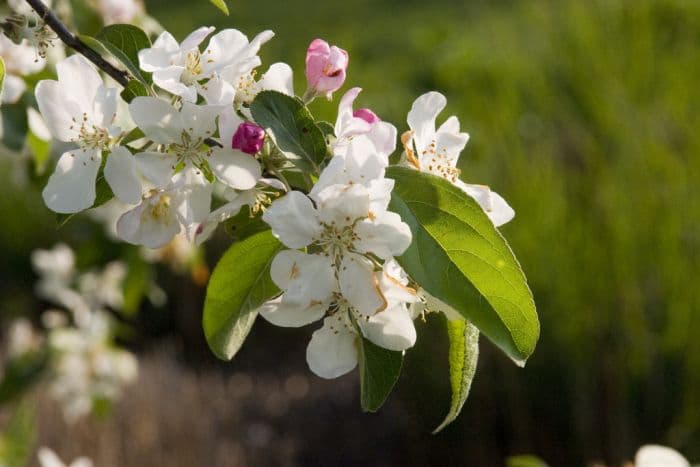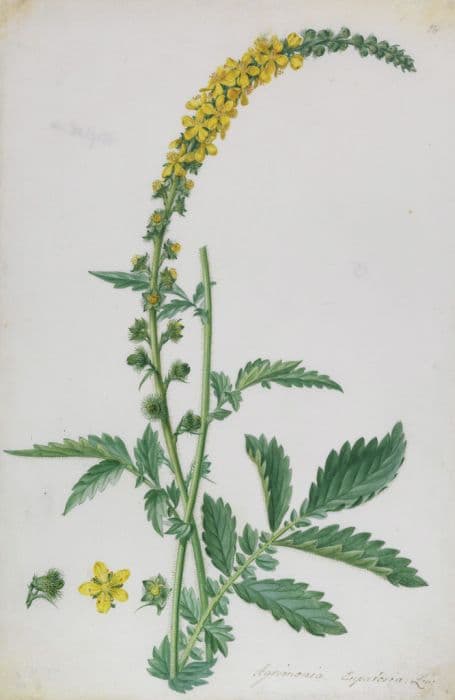Crabapple Malus × atrosanguinea 'Gorgeous'

ABOUT
The plant known as Gorgeous flowering crabapple is renowned for its ornamental qualities that make it a standout in any landscape. It bears a prolific display of stunning flowers that mainly come in striking shades of red and pink. These blossoms are not only visually appealing but also offer a delightful fragrance that can be sensed from a distance, especially during the peak blooming season. After the flowering period, the Gorgeous crabapple produces tiny apple-like fruits that add to the visual interest of the plant. These fruits are commonly red or reddish-purple, contributing to the plant's overall colorful display throughout the seasons. The leaves of the plant are also worth noting; they are typically green, sometimes with reddish tones, and transform into beautiful hues during the autumn months, providing an extended period of color. With its combination of floral beauty, attractive foliage, and charming fruits, the Gorgeous flowering crabapple is a cherished option for gardeners looking to amplify the aesthetics of their outdoor spaces.
About this plant
 Names
NamesSynonyms
Gorgeous Crabapple, Purple Crabapple, Red-Fleshed Crabapple.
Common names
Malus × atrosanguinea 'Gorgeous'.
 Toxicity
ToxicityTo humans
The plant in question is known as Crabapple. Crabapple trees are not considered highly toxic to humans. However, the seeds inside the crabapple fruit contain cyanogenic glycosides, which can release cyanide when chewed and digested. Eating a small number of seeds is unlikely to cause harm, but consuming a large quantity could potentially lead to symptoms of cyanide poisoning. These symptoms may include headache, dizziness, difficulty breathing, and an increased heart rate. In severe cases, seizures, coma, or even death could occur. It is generally advised to avoid ingesting the seeds from crabapples to prevent any risk of toxicity.
To pets
The plant in question is known as Crabapple. Crabapple trees are not considered highly toxic to pets, but they can cause some gastrointestinal upset if ingested in large quantities. The primary concern is the seeds, which contain cyanogenic glycosides, capable of releasing cyanide when digested. If a pet consumes a large number of crabapple seeds, it may exhibit symptoms of cyanide poisoning, such as drooling, dilated pupils, difficulty breathing, and shock. In extreme cases, ingestion can be fatal. It is best to prevent pets from consuming crabapple seeds to avoid the risk of poisoning.
 Characteristics
CharacteristicsLife cycle
Perennials
Foliage type
Deciduous
Color of leaves
Green
Flower color
Pink
Height
12-15 feet (3.6-4.5 meters)
Spread
12-15 feet (3.6-4.5 meters)
Plant type
Tree
Hardiness zones
4-8
Native area
Asia
Benefits
 General Benefits
General Benefits- Ornamental Appeal: The plant has vibrant flowers which enhance the aesthetic appeal of gardens and landscapes.
- Wildlife Attraction: Its blossoms attract pollinators such as bees and butterflies, promoting biodiversity.
- Shade Provision: As a tree, it can provide shade in gardens and outdoor spaces during sunny days.
- Seasonal Interest: Offers changing visual interest throughout the seasons with flowers in spring and colored leaves in autumn.
- Privacy Screen: When planted in a row or group, it can act as a natural privacy screen.
- Fruit Production: Produces small apple-like fruits that can be attractive, though they are often not eaten.
- Hardiness: Often robust and can survive in a range of temperate climates with minimal care once established.
 Medical Properties
Medical PropertiesThis plant is not used for medical purposes.
 Air-purifying Qualities
Air-purifying QualitiesThis plant is not specifically known for air purifying qualities.
 Other Uses
Other Uses- Photography Prop: The Malus × atrosanguinea 'Gorgeous', with its striking blossoms, provides a stunning backdrop for outdoor portrait photography.
- Educational Tool: Botany students can study this plant to learn about hybridization and flowering patterns in angiosperms.
- Bird Habitat: The tree can offer shelter and nesting sites for birds, while its fruit serves as a food source.
- Dye Production: The deep red blossoms can be used to create natural dyes for fabrics and artwork.
- Ice Cream Flavoring: The fruit of the tree can sometimes be used in artisanal ice cream making for a unique flavor.
- Wedding Decor: Its branches and blossoms can be integrated into wedding ceremonies as part of the décor for a natural touch.
- Homemade Crafts: Dried flowers and branches can be used in homemade craft projects like wreath making.
- Culinary Events: Blossoms of the tree could be used to garnish dishes and add elegance to food presentation at culinary events.
- Seasonal Festivals: The tree can be a focal point in spring festivals to celebrate the season with its eye-catching display of flowers.
- Art Subjects: Artists may use the plant as a subject for painting, sketching, or digital art due to its visual appeal.
Interesting Facts
 Feng Shui
Feng ShuiThe Crabapple tree is not used in Feng Shui practice.
 Zodiac Sign Compitability
Zodiac Sign CompitabilityThe Crabapple tree is not used in astrology practice.
 Plant Symbolism
Plant Symbolism- Beauty: The cultivar name 'Gorgeous' itself reflects its association with beauty and visual appeal due to its attractive blooms.
- Love and Temptation: As part of the apple tree family (Malus), this plant symbolizes love and temptation, harking back to the biblical story of Adam and Eve.
- Knowledge and Enlightenment: Apples are often connected with knowledge and enlightenment, given their mythological ties to the fruit of wisdom.
- Peace: In some cultures, apple blossoms are seen as a symbol of peace and tranquility.
- Youthfulness: The vibrant and fresh blossoms of the apple tree reflect youth and rejuvenation.
 Water
WaterThe Gorgeous crabapple requires regular watering to maintain moist, but not waterlogged, soil conditions. Water this plant deeply once a week with about 1-2 inches of water, ensuring that the water penetrates the soil to reach the tree's roots. During hot or dry periods, increase watering frequency to twice per week, but always check the soil moisture before watering again to avoid overwatering. In the fall, gradually reduce watering to help the tree harden off for winter. Always water at the base of the tree, avoiding wetting the foliage to reduce the risk of disease.
 Light
LightGorgeous crabapples thrive in full sun, which means they need at least six hours of direct sunlight each day. The ideal spot for planting is in an area that receives unfiltered sunlight throughout the day. Avoid shaded areas as insufficient light can lead to poor flowering and fruiting.
 Temperature
TemperatureGorgeous crabapples are hardy and can tolerate a range of temperatures; they can survive winter chill down to approximately -20°F and can handle summer heat up to around 90°F. However, an ideal temperature range for optimal growth and flowering is between 60°F and 75°F. These trees can handle slight variations outside these ranges but extreme temperatures for prolonged periods may stress the plant.
 Pruning
PruningPrune Gorgeous crabapples to maintain health, shape, and to encourage better flowering and fruiting. Pruning is best done in late winter or early spring while the tree is still dormant, before new growth starts. Remove any dead, damaged, or diseased branches, and thin out crowded areas to improve light penetration and air circulation. Pruning should be done selectively and not more than necessary to maintain the natural form of the tree.
 Cleaning
CleaningAs needed
 Soil
SoilThe ornamental crabapple prefers well-drained, moderately fertile soil with a pH of 6.0 to 7.0. A mixture of garden soil, compost or well-rotted manure, and sand can create a suitable environment for healthy growth. Ensuring the soil is not too heavy or clay-rich is important to avoid waterlogging.
 Repotting
RepottingOrnamental crabapples grown in a pot should be repotted every 2-3 years, preferably in early spring before new growth begins. This helps to refresh the soil and provide the tree with more room to grow.
 Humidity & Misting
Humidity & MistingThe ornamental crabapple thrives in average outdoor humidity levels. They do not have specific humidity requirements and grow well in the natural humidity range of most temperate climates.
 Suitable locations
Suitable locationsIndoor
Not suitable for indoor growing; needs full sun.
Outdoor
Plant in full sun, well-drained soil, and water regularly.
Hardiness zone
4-8 USDA
 Life cycle
Life cycleThe life cycle of the Malus × atrosanguinea 'Gorgeous', commonly known as the "Gorgeous crabapple," begins with seed germination, where stratification is often needed as it mimics natural winter conditions for the seeds to sprout. After germination, the seedling stage follows where the plant establishes roots and sprouts its first leaves, gradually developing into a juvenile tree. As it matures, the tree enters the vegetative stage, producing a robust structure with branches and foliage, and it typically takes several years to reach reproductive maturity. Once mature, the Gorgeous crabapple blossoms annually in spring, displaying vibrant pink flowers that attract pollinators like bees. Following pollination, the flowers develop into crabapples, which are small, ornamental fruits that may be used for jelly or left on the tree for ornamental value and wildlife food. Finally, the tree may go into a period of dormancy during winter, shedding its leaves, and enter a cycle of renewal with the return of spring.
 Propogation
PropogationPropogation time
Spring-Early Summer
The crabapple 'Gorgeous' is commonly propagated by grafting, which is a method that joins the tissue of one plant with the tissue of another so they continue their growth together. The best time for grafting this specific variety is late winter or early spring, just before growth begins. During this period, while the rootstocks are still dormant, a small branch or bud from the 'Gorgeous' crabapple is inserted into a cut on the rootstock. The grafting area is then tightly wrapped and sealed to prevent disease and desiccation. This method ensures that the new plants will bear the same beautiful flowers and fruit as the parent plant. Over time, the grafted union will heal, fusing the two plant parts together to form a single vascular system, thereby developing into a mature, fruiting tree.









